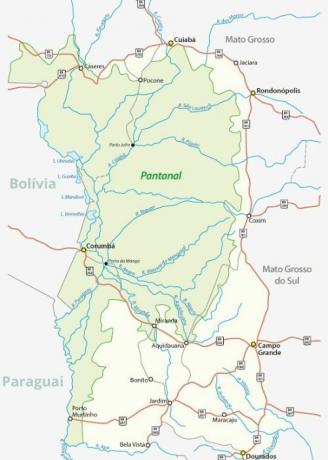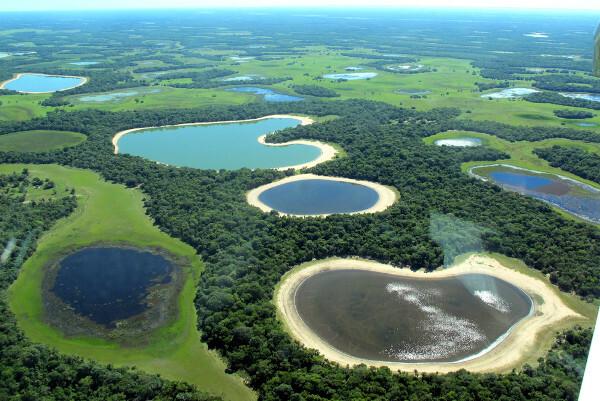O wetland it is one of the smallest existing biomes in Brazil. Your location is in the Midwest region, in the states of Mato Grosso (in the south of the state) and Mato Grosso do Sul (in the northwest of the state), in addition to being found in Paraguay and Bolivia.
It is a extremely biome rich when it comes to Brazilian fauna, as it houses most of the animals that exist in Brazil. Its environmental preservation is high, being considered the most preserved biome in the country according to government agencies such as the Brazilian Institute of Geography and Statistics.
Read too: Regions of Brazil - groupings of states with similar characteristics
Pantanal Features
The Pantanal has great integration of other biomes, and may have areas of occurrence with the thick, a Caatinga, and rainforests. However, the main feature of this biome is its flooded plain., its registered trademark in Brazil.
Pantanal location
this biome can be found in 22 Brazilian cities, in the states of Mato Grosso and Mato Grosso do Sul. Its area of occurrence is limited to the west of these states, on the borders with Paraguay and Bolivia. Thus, the Pantanal can also be found in these two countries.

The area covering this biome reaches 220 thousand km², being 120 thousand km² on Brazilian soil. In Brazil, the Pantanal area occupies approximately 2% of the country's territory. is the smallest brazilian biome.
Pantanal soil
Most of the Pantanal soils are fromflat land floodable, natural feature of the region. This is a boon, but at the same time it is harmful from an agricultural point of view, because with this flood, many areas have low fertility, which leads to the use of pesticides and chemical inputs, the agrochemicals, for the cultivation of soybeans and the like.
Flooding causes organic matter to decompose slowly, so it is not very fertile soil. That ground it comes from erosive processes in the higher lands, the plateaus from the Pantanal, common in the most eastern areas of the biome. In these areas, the terrain is sandy and acidic, also with low fertility.
Do not stop now... There's more after the advertising ;)
Pantanal vegetation
As it is a biome with close links to the Amazon rainforest and to the Cerrado, the Pantanal landscape is very diverse, with medium and large trees, typical of the Amazon, but also has the presence of tortuous trees of small and medium size, very common in the Cerrado.
In the riparian forests, near the rivers, it is common to find genipap trees 20 meters high, an Amazon tree. In this area, the vegetation is dense and lush, with fig trees, inazeiros, and other tall trees.
At flood plains do Pantanal have vegetation typical of this location, such as the aquatic vegetablesAttractions: water hyacinth, yerba-de-santa-luzia, utriculária and cabomba, many of them used for medicinal purposes.
In areas not so flooded, the presence of Cerrado trees is frequent, such as ipe and buritis.
Pantanal climate
The Pantanal is located in an area of occurrence of the tropical weather, with two well-defined seasons: the summer rainy and the Winter dry. This fact is essential for the tourist activity in the region, one of the great drivers of the economy.
The rains are concentrated from October to March, a period when tourism is limited and fishing is prohibited between November and February, as it coincides with the reproduction of fish. At that time, the temperature exceeds 30 ºC.
Between April and September, the absence of rain is marked by beautiful landscapes that attract tourists from all corners, both Brazilians and foreigners. The mild temperature, between 20 ºC and 25 ºC, contributes to local economic activities, such as boat trips, commerce and agricultural practices.
Read too: What is the difference between weather and climate?
Pantanal relief
The Pantanal is located in a area surrounded by plateaus that reach, on average, 700 meters of altitude. This elevation around the biome is responsible for the sources of the various Pantanal rivers. However, the Pantanal itself has altitudes that do not exceed 120 meters. As a result, more than 80% of the biome is flooded in summer, a time of intense rain.

Of the surrounding plateaus, the most famous is the Urucum massif, in Mato Grosso do Sul, with a peak 1065 meters high. In this relief unit, we find one of the largest reserves of manganese in Brazil, a mineral widely used in steel industries.
Pantanal hydrography
THE Water in the Pantanal is a decisive factor in the balance of fauna and flora. During summer floods, it is estimated that 180 million liters of water reach the biome plain.
All this water accumulates in the plain, forming the flooded areas: swamps, swamps, lakes and bays that connect to the rivers. The relief contributes to this connection due to its low slope.
Among the countless rivers in the region, we can highlight the Cuiabá river, the Taquari river, the Itiquira river, the Aquidauana river, in addition to the Paraguai river, one of the largest in the locality.
Pantanal fauna
The fauna present in the Pantanal is very rich, concentrating almost all the animals that live in Brazil. This fact occurs because this biome is directly influenced by three large Brazilian biomes: Amazon Forest, Cerrado and Atlantic forest, in addition to having some areas with remnants of the Caatinga.
According to the IBGE News Agency, the Pantanal contains:
132 species of mammals: tapir, capybara, deer, jaguar, bat;
85 species of reptiles, being the alligators with the greatest variety;
463 species of birds: toucan, macaw, tuiuiu, carão;
35 species of amphibians, like the green frog;
263 species of fishAttractions: pacu, painted, catfish, traíra, dorado, piau, jaú (the largest in the region).

With all this wealth, the Pantanal suffers from illegal hunting and fishing. One of the great targets of hunters is the alligator, a very common animal in this region. In addition, the goldfish is also on the list of endangered animals by fishermen, which led to their fishing ban. However, even with the strictness of the law, supervision is lacking, leading to constant illegal attacks.
Also access: Consequences of anthropic actions on the environment
Pantanal economic aspects
The Pantanal economy revolves around the fishing and tourism activities. However, cattle raising was recently included in the region's activities, mainly in the state of Mato Grosso.
In the cities of Cáceres (MT) and Corumbá (MS), there are inns that shelter tourists during the high season, which runs from June to September. These inns are called boat-hotels, as many residents of the region transform their boats into hotels and become guides for fishermen from all over Brazil and also from other countries. During the months of November to February, fishing in Pantanal areas is prohibited, as it is the period of piracema, time when fish migrate and reproduce.
THE livestock attracts many Mato Grosso farmers who use the flat areas of the region to raise their cattle. In addition, the good humidity of the place guarantees plenty of food for the animals. To cross flooded areas, most cattle raisers injure an ox. This one, when bleeding, attracts piranhas, which are quite common in some rivers. With this, the attention of these fish turns to this ox, making the rest of the herd cross safely.
Cattle breeding manages to develop in a sustainable way, generating employment and income. However, in recent decades, the soy cultivation in Mato Grosso it entered the Pantanal, which can be a dangerous act, as this cultivation uses a significant amount of pesticides, generating problems for the entire Pantanal ecosystem.
In tourism, it is quite common to go on a chalana, a large flat-bottomed vessel, typical of this region and used to transport people along the rivers of the Pantanal.
Environmental impacts in the Pantanal
In the Pantanal region, and in almost the entire state of Mato Grosso do Sul and Mato Grosso, agricultural activities are extremely important to the economy. However, when these activities are done in an exaggerated way regarding the use of soil and chemical fertilizers, serious impacts arise on the environment, and in some cases are irreversible.
In relation to the Pantanal, agriculture with the cultivation of soy has caused concern for the local and regional population, as the environmental impacts are not restricted to its area of occurrence.
One of the cases that most concern the Brazilian Agricultural Research Corporation (Embrapa) is the contamination of the Taquari river basin, with serious threats to the local fauna and flora.
The Taquari River is born in the extreme south of Mato Grosso and runs east-west, towards Mato Grosso do Sul, being one of the tributaries of the Paraguay River, one of the main rivers in the Platina Basin.
This Pantanal river suffers from a serious problem ofsilting caused by the removal of part of the forest in its upper part for the insertion of pastures and soy crops. In addition, soy monoculture uses agrochemicals and pesticides that contaminate the soil and damage the entire regional ecosystem, causing serious problems for the biome.
When does the removal of natural vegetation for agricultural practices, the erosive process is accentuated, generating silting that is so worrying among environmental entities.
Another factor that concerns the preservation of the Pantanal is associated with illegal hunting and fishing practices in the region. Due to its large flooded area, the biome has a rich aquatic fauna, but some fish, such as dorado, are prohibited. Hunting alligators of certain species is also prohibited, but this does not prevent fishermen and hunters from venturing into the Pantanal in search of these animals. However, this search harms the food chain of the region, generating an ecological imbalance, which, over time, aggravates the reproduction of species and the preservation of natural resources.
In the Pantanal plateaus, Embrapa is investigating the exploration of gold and diamond mining made in an unsustainable way, contaminating rivers and soils with mercury, which leads to direct contamination of the animals that live there.
Such problems show that there is a lack of a major environmental project that can guarantee the sustainable use of the Pantanal, with planning and sustainability, ensuring the continuity and status of being the most preserved biome in the country.
Read too: Environmental impacts caused by mining
Pantanal Curiosities
Such a rich biome also has several curiosities, from geographical to those related to the fauna present in it. Let's look at some.
65% of the Brazilian Pantanal is in the state of Mato Grosso do Sul, and the remainder (35%) in Mato Grosso.
In Bolivia and Paraguay, the Pantanal is called chaco.
The symbol bird of the Pantanal is the Tuiuiu.
During the flood season, up to 80% of the Pantanal plain is flooded. It is the largest floodplain in the world.
The presence of the second largest snake in the world, the anaconda, which can measure up to nine meters in length, is quite common in the Pantanal.
Alligators are common in the Pantanal, but they only attack humans if they are threatened.

Unesco considers the Pantanal a Natural Heritage Site and a World Biosphere Reserve.
November 12th is considered Pantanal Day, in memory of environmentalist Francisco Anselmo de Barros, an important icon for Pantanal environmental issues.
There are more fish in the Pantanal than in all European rivers put together.
By Attila Matthias
Geography teacher

